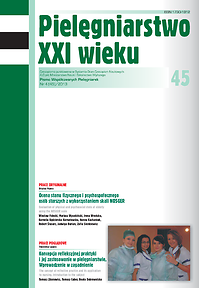The concept of reflective practice and its application to nursing. Introduction to the subject
DOI:
https://doi.org/10.12923/Keywords:
nursing, reflective practice, nursing professional educationAbstract
THE CONCEPT OF REFLECTIVE PRACTICE AND ITS APPLICATION TO NURSING. INTRODUCTION TO THE SUBJECT
The aim of this article is to present the possibility of application of the conception of reflective practice to everyday practice of nurse. Contemporary Polish nursing is in the process of many changes. Polish nurse is in a process of transition between working in a system based on the physicians’ orders and working as independent, professional worker for whom these orders are only part of everyday work. In order to meet new requirements nursing education has been transferred to the academic level. Additionally, nursing standards and algorithms supposed to be helpful in the work with the patient. Thanks to them nursing is in some sense unified and its quality increasing. However, following standards can result mechanical work with patients with similar problems and schemas of collecting interviews can remain conversation which is limited to the minimum necessary. Applying the concept of reflective practice seems to be the way which gives nursing standards ‘human face’. “Reflection on action” and ‘reflection in action’ compels nurses to the broader perspective when they deal with clinical problems. Reflective practice is a helpful way of dealing with difficult and unusual situations. And finally, it is the excellent proposal for the self-development. Its application allows analysis of nurses’ experience in the light of knowledge they have what in turns contributes to the nursing practice development.
References
1. Ciechaniewicz W. Dawca i biorca pielęgnowania. [w:] Ślusarska B, Zarzycka D, Zahradniczek K, red. Podstawy pielęgniarstwa. Tom I. Lublin: Czelej, 2004; s. 293-338.
2. Poznańska S. Pielęgniarstwo i jego istota. [w:] Ślusarska B, Zarzycka D, Zahradniczek K, red. Podstawy pielęgniarstwa. Tom I. Lublin: Czelej, 2004; s. 21-35.
3. Zarzycka D. Definiowanie pielęgnowania. [w:] Ślusarska B, Zarzycka D, Zahradniczek K, red. Podstawy pielęgniarstwa. Tom I. Lublin: Czelej, 2004; s. 163-189.
4. Ustawa z dnia 15 lipca 2011 r. o zawodach pielęgniarki i położnej. Dz.U. 2011 nr 174 poz. 1039.
5. Alexander Ch. Notes on the Synthesis of Form. Harvard University Press 1964.
6. Pearson AT. Nauczyciel. Teoria i praktyka w kształceniu nauczycieli. Warsza wa: WsiP; 1994.
7. Schön D. The Reflective Practicioner. How professionals thinkin action. Basic Books 1983.
8. Johns Ch. Becoming a reflective practitioner. Blackwell Publishing, Oxford Malden, MA 2004.
9. Clinton M. On reflection in action: Unaddressed issues in refocusing the debate on reflective pratice. International Journal of Nursing Practice 1998, 4: 197-202.
10. Cooney A. Reflection demystified: answering some common questions. British Journal of Nursing 1999, 8 (22): 1530-1534.
11. Ruth - Sahd L. Reflective Practice: A Critical Analysis of Data-Based Studies and Implications for Nursing Education. Journal of Nursing Education 2003, 42(11): 488-497.
12. Clarke M. Action and reflection: practice and theory in nursing. Journal of Advanced Nursing 1986, 11: 3-11.
13. Heath H. Reflection and patterns of knowing in nursing. Journal of Advanced Nursing 1998, 27: 1054-1059.
14. Lockyer J, Gondocz T, Thivierge R. Knowledge Translation: The Role and Place of Practice Reflection. The Journal of Continuing Education in the Health Professions 2004, 24: 20-56.
15. Wrońska I. Historyczne i społeczne uwarunkowania rozwoju pielęgniarstwa. [w:] Ślusarska B, Zarzycka D, Zahradniczek K, red. Podstawy pielęgniarstwa. Tom I. Lublin: Czelej 2004; s. 36-46.
16. Paget T. Reflective practice and clinical outcomes: practitioners’ views on how reflective practice has influenced their clinical practice. Journal of Clinical Nursing 2001, 10: 204–214.
17. Plack M, Santasier A. Reflective Pratice: A Model for Facilitating Critical Thinking Skills Within an Integrative Case Study Class room Experience. Journal of Physical Therapy Education 2004, 18 (1): 4-12.
18. Rolfe G. Beyond expertise: theory, practice and the reflexive practitioner. Journal of Clinical Nursing 1997, 6: 93-97.
19. Andrew, M. E. (1996): Reflection as infiltration: learnig in the experimental do main. Journal of Advanced Nursing, 24, s. 391-399.
20. Cotton AH. Private thoughts in public spheres: issues in reflection and reflective practices in nursing. Journal of Advanced Nursing 2001, 36(4): 512-519.
21. Teekman B. Exploring reflective thinking in nursing practice. Journal of Advanced Nursing 2000, 31(5): 1125-1135.
22. Benner P. From Novice to Expert. Excellence and power in clinical nursing practice. Menlo Park, CA: Addison-Wesley 1984.
23. Polanyi M. The Logic of Tacit Inference. Philosophy 1996, 41(1): 1–18.
24. Polanyi M, Sen A. The tacit dimension. University of Chicago Press 2009.
25. Seed J. Reflection on action: communication is the key. Journal of Perioperative Practice 2006, 16 (12): 581-584.
26. Smyth W J. Reflection-in-Action. Deakin University, Victoria 1986.
27. Poznańska S. Komunikowanie w relacjach pielęgniarka pacjent. [w:] Zahradniczek K, red. Wprowadzenie do pielęgniarstwa. Podręcznik dla szkół medycznych. Warszawa: Wydawnictwo Lekarskie PZWL, 1995.
28. Boud D, Walker D. Promoting reflection in professional courses. The challange of context. [w:] Harrison R, Reeve F, Hanson A, Clarke J, red. Supproting Lifelong Learning. Volume I. Perspectives of Learning. Routledger Falemer, London 2002, s. 91-110.
29. Butterworth T, Faugier J. Clinical supervision and mentorship in nursing. 1st edition, Chapman and Hall, London 1992.
30. Lyth GM. Clinical supervision: a concept analysis. Journal of Advanced Nursing 2000, 31: 722-729.
31. Kilcullen N. Ananalysis of the experiences of clinical supervision on Registered Nurses undertaking MSc/graduate diploma in renal and urological nursing and on their clinical supervisors. Journal of Clinical Nursing 2007, 16: 1029-1038.
Downloads
Published
Issue
Section
License
Copyright (c) 2013 Tomasz Zdanowicz, Tomasz Cuber, Beata Dobrowolska (Autor)

This work is licensed under a Creative Commons Attribution 4.0 International License.




